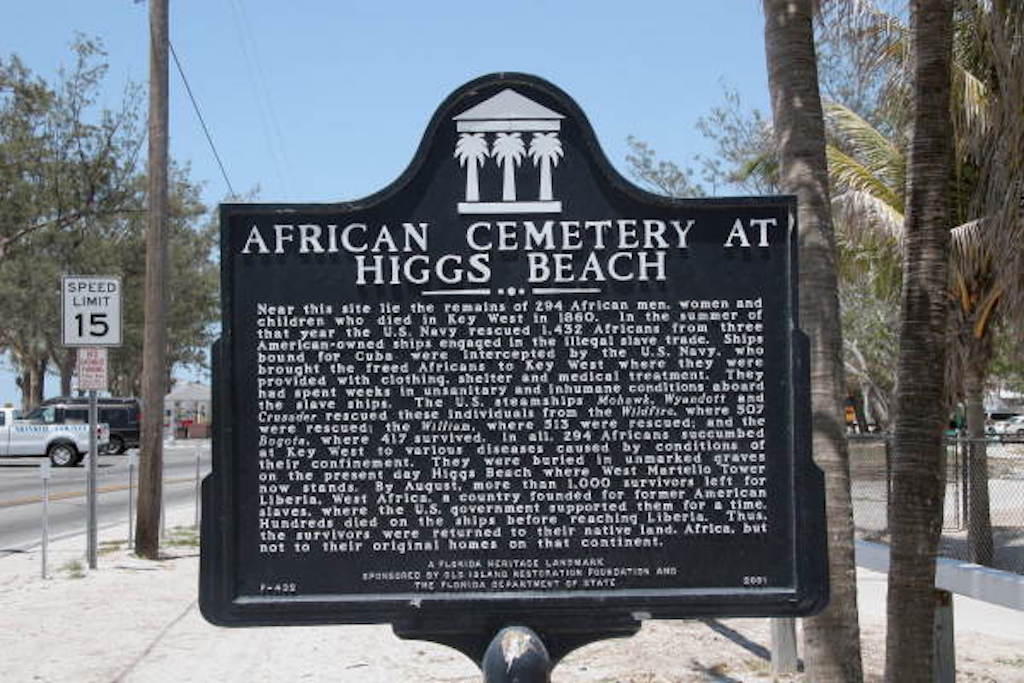The Key West Slave Cemetery is one of the most historical sites in Key West.
The burial ground holds the remains of enslaved people who were brought to Key West in 1860, who died on the island.

The deceased victims were refugees and survivors, saved from three illegal slave ships which were intercepted by the US Navy off the coast of Key West.
The site marks the final resting place of 294 men, women and children.
The memorial is a unique and significant piece of America’s African history, and an important reminder of a shameful period of our country’s history.
A Tragic Story
In 1860 three slave ships were intercepted off the coast of Key West.
The three ships carried 1,432 men, women, and children, kidnapped from Africa, who were going to be illegally sold into the American slave trade.
The illegal slave ships were intercepted by the US Navy, and the enslaved people were freed.
The slave trade was made illegal in 1820, although the practice of slavery remained legal in the U.S. until they were freed by the emancipation proclamation in 1863.
The survivors were brought to Key West, where island locals tried to help them. A hospital was created to provide medical care.
The refugees were given aid, but hundreds of the survivors died.
Tragic Loss of Life
Tragically, 294 of the people died in Key West due to illness, injury, mistreatment and the unlivable conditions they experienced on the ships.
The deceased were buried in unmarked graves in Key West, but the cemetery was forgotten. It was only rediscovered later, during construction of the West Martello Tower.
The remaining survivors were sent to the African country of Liberia, which was established for the resettlement of freed slaves.
However, hundreds more of the refugees died in transit, or when they arrived in Liberia.
A Burial Site, Lost to History
The African cemetery was forgotten and lost to history, but the burial ground was re-discovered during the construction of a military fort, the West Martello Tower.

Tragically, the cemetery was relocated and forgotten about again. It was eventually rediscovered in 2002 with the use of specialized ground-penetrating radar.
Historical Significance
The Key West African burial memorial is a significant historical monument. It is the only known cemetery of African slave refugees, as opposed to people who died while enslaved.
The Key West Slave Cemetery was added to the National Register of Historic Places because of its unique historical and archaeological significance.
The cemetery is bordered by a black wrought iron fence and has memorials plaques on-site to provide historical context and to mark the site.

The on-site plague reads:
“Near this site lie the remains of 294 African men, women and children who died in Key West in 1860. In the summer of that year the U.S. Navy rescued 1,432 Africans from three American-owned ships engaged in the illegal slave trade. Ships bound for Cuba were intercepted by the U.S. Navy, who brought the freed Africans to Key West where they were provided with clothing, shelter and medical treatment. They had spent weeks in unsanitary and inhumane conditions aboard the slave ships. The U.S. steamships Mohawk, Wyandott and Crusader rescued these individuals from the Wildfire, where 507 were rescued; the William, where 513 were rescued; and the Bogota, where 417 survived. In all, 294 Africans succumbed at Key West to various diseases caused by conditions of their confinement. They were buried in unmarked graves on the present day Higgs Beach where West Martello Tower now stands. By August, more than 1,000 survivors left for Liberia, West Africa, a country founded for former American slaves, where the U.S. government supported them for a time. Hundreds died on the ships before reaching Liberia. Thus, the survivors were returned to their native land, Africa, but not to their original homes on that continent."
Visitor Information

There is no fee to visit the Key West African Cemetery.
There is free parking on-site and nearby.
The surrounding area around the cemetery is a nice place to visit and one of the best things to do in Key West for families and people who are interested in history.
Other attractions nearby include:
- The Key West Aids Memorial
- West Martello Tower
- Higgs Beach
- Rest Beach
- The White Street Pier
- a large Monroe County Park
- And more.
The Key West Slave Cemetery is an important reminder of the horrors of slavery and the resilience of those who survived.
It is a somber memorial, and a site which should be visited and respected for the significance it holds for our shared past.